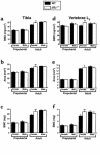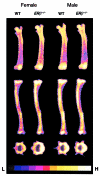Increased cortical bone mineral content but unchanged trabecular bone mineral density in female ERbeta(-/-) mice
- PMID: 10510330
- PMCID: PMC408552
- DOI: 10.1172/JCI6730
Increased cortical bone mineral content but unchanged trabecular bone mineral density in female ERbeta(-/-) mice
Abstract
Ovariectomy in young, growing rodents results in decreased trabecular bone mineral density (BMD) and increased radial growth of the cortical bone. Both of these effects are reversed by treatment with estrogen. The aim of the present study was to determine the physiological role of estrogen receptor-beta (ERbeta) on bone structure and bone mineral content (BMC). The BMC was increased in adult (11 weeks old), but not prepubertal (4 weeks old), female ERbeta(-/-) mice compared with wild-type (WT) mice. This increase in BMC in females was not due to increased trabecular BMD, but to an increased cross-sectional cortical bone area associated with a radial bone growth. Male ERbeta(-/-) mice displayed no bone abnormalities compared with WT mice. Ovariectomy decreased the trabecular BMD to the same extent in adult female ERbeta(-/-) mice as in WT mice. The expression levels of osteoblast-associated genes - alpha1(I) collagen, alkaline phosphatase, and osteocalcin mRNAs - were elevated in bone from adult ERbeta(-/-) females compared with WT mice. These observations provide a possible explanation for the increased radial bone growth seen in female mutants, suggesting a repressive function for ERbeta in the regulation of bone growth during female adolescence. In summary, ERbeta is essential for the pubertal feminization of the cortical bone in female mice but is not required for the protective effect of estrogens on trabecular BMD.
Figures



References
-
- Turner RT, Riggs BL, Spelsberg TC. Skeletal effects of estrogen. Endocr Rev. 1994;15:275–300. - PubMed
-
- Lindsay R, et al. Long-term prevention of postmenopausal osteoporosis by oestrogen. Evidence for an increased bone mass after delayed onset of oestrogen treatment. Lancet. 1976;1:1038–1041. - PubMed
-
- Eriksen EF, et al. Evidence of estrogen receptors in normal human osteoblast-like cells. Science. 1988;241:84–86. - PubMed
-
- Komm BS, et al. Estrogen binding, receptor mRNA, and biologic response in osteoblast-like osteosarcoma cells. Science. 1988;241:81–84. - PubMed
-
- Smith EP, et al. Estrogen resistance caused by a mutation in the estrogen-receptor gene in a man. N Engl J Med. 1994;331:1056–1061. - PubMed
Publication types
MeSH terms
Substances
LinkOut - more resources
Full Text Sources
Other Literature Sources
Medical
Molecular Biology Databases

